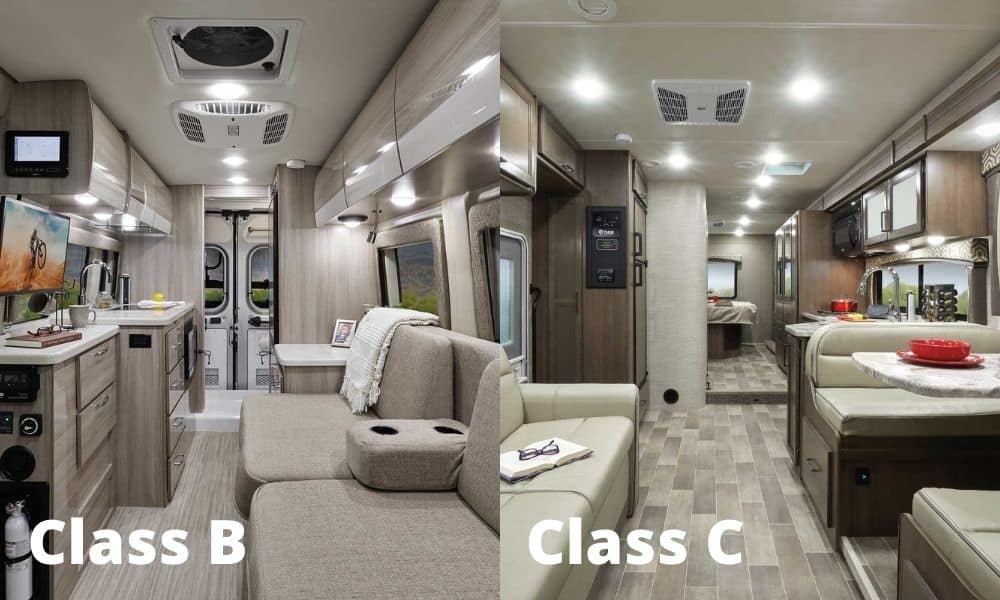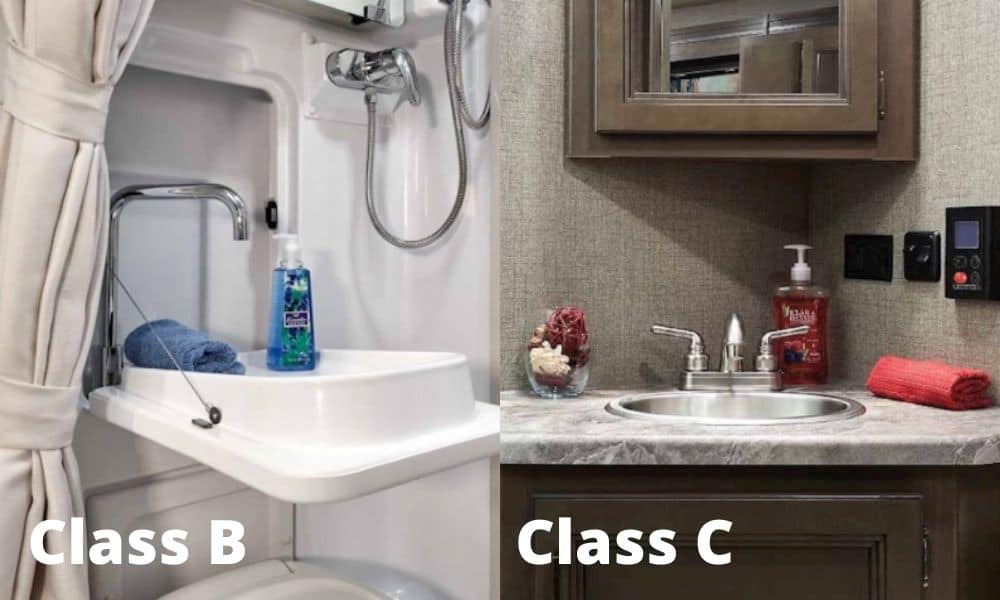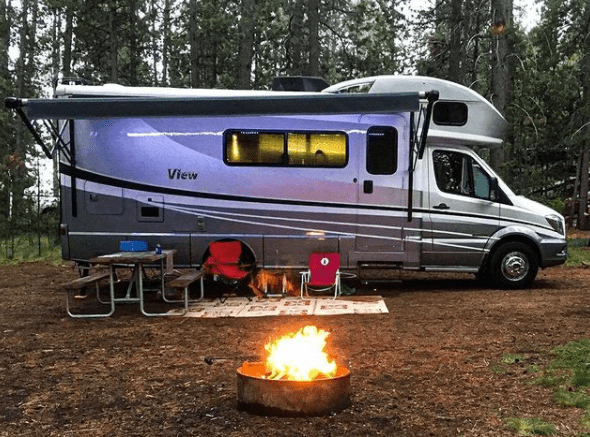If you’ve been thinking about buying a small RV lately, you’ve probably been trying to decide between a Class B or a Class C motorhome, and wondering which one is the better choice.
The truth of the matter though, is that there is no one right answer to this question, as they each have their own pros and cons.
So if you’re trying to decide between a Class B and Class C motorhome, make sure to keep reading.
As we go over all the differences between the two types of RVs and give the pros and cons for each.
What’s the Difference Between a Class B and Class C RV?
One of the best ways to decide between a Class B and a Class C RV is to take a look at all the differences between the two motorhomes in order to decide which RV might be the best fit for you and your needs.
Miles Per Gallon: Class B vs Class C
The Class B RV is the clear winner when comparing miles per gallon, as the Class B RV usually gets almost double the miles per gallon compared to the Class C RV.
- Class B MPG – 18 to 20 miles per gallon
- Class C MPG – 10 to 15 miles per gallon
The main reason for this is due to the size difference between a Class B and a Class C RV. As a Class C RV is substantially bigger as well as heavier which leads to poor mpg compared to the Class B RV.
Interior Space: Class B vs Class C

When it comes to interior space, the class C motorhome has substantially more interior space and room compared to the class B motorhome.
Which goes a long way in making the Class C RV feel more like a home away from home, as opposed to the Class B motorhome which pretty much feels like you’re hanging out in a van.
Why Class C’s Have More Interior Space than Class B’s
The Class C RV is able to achieve all this extra interior space because of three key design differences between the Class C RV and the Class B RV.
The first being that the Class C RV is usually over a foot wider compared to the Class B RV, which really helps with interior walking space inside the RV.
The second reason a Class C feels so much bigger inside is the interior ceiling height of the coach.
As a Class C RV typically has an interior ceiling height of around 7 feet while a Class B RV usually only has a ceiling height of just over 6 feet.
And while you might think that less than a foot of difference in ceiling height between the RVs wouldn’t be that big of a deal, that extra foot in height really goes a long way in helping the Class C RV feel much more spacious and open inside.
The third and final reason why Class C RVs have so much more interior space compared to Class B RVs is that Class C RVs almost always utilize slide-outs, which can often double the interior space of the RV.
Amenities: Class B vs Class C
While both Class B and Class C RVs have similar amenities, thanks to the additional space found in Class C RVs the class C tends to win out when it comes to overall comfort and amenities over the Class B RV.
For instance, even though most class B’s and all class C’s have a bathroom, just look at the difference between a typical class B bathroom sink and a class C bathroom sink.

Now, which one would you rather use, the Class B bathroom or the Class C bathroom?
The reason there is such a stark difference between these two types of bathrooms is the Class C will always have more interior space to work with compared to Class B RVs.
And because of this, most Class B bathrooms are usually small wet baths while Class C RVs have bathrooms more like your bathroom at home, albeit a smaller version of it.
And it’s not just the bathroom that’s impacted.
As the additional space found in Class C RVs, also provides better sleeping capacity, larger dining areas, and nicer kitchens.
In regards to sleeping capacity though, there are some Class B RVs that rival the sleeping capacity of a Class C RV, which you can check out by taking a look at our article “10 Awesome Class B RVs that Actually Sleep 4“.
Storage: Class B vs Class C
As you might have guessed the Class C easily beats out the Class B RV, when it comes to storage, thanks to the ample interior and exterior storage space offered on Class C motorhomes.
Because while Class B RVs will usually have one small wardrobe, maybe a few overhead bins, and little to no exterior storage.
A Class C RV will usually have a large wardrobe for clothes, a pantry in the kitchen area, tons of overhead storage, and ample exterior storage.
Driveability and Parking: Class B vs Class C
While driving a Class B or Class C takes some getting used to, the Class B is generally easier to drive, thanks to its smaller size and van chassis.
In fact, most people say a Class B is pretty much like driving a really big van.
However, there are things you will need to get used to when driving a Class B such as its longer wheelbase, which can affect its turning radius as well as its blind spots.
As far as parking goes the Class B wins out again, thanks to its smaller stature and size.
This allows you to park a Class B pretty much anywhere including most standard parking spots as well as smaller National Park campsites.
How to Decide Between a Class B and a Class C
Now that we know some of the main differences between a Class B and Class C RV, it’s important to know how to decide between the two.
And the best way to decide what type of RV is best for you and your family is to think about how you and your family plan to use the RV.
The Three Main Styles of RVs
When trying to decide which type of RV will be best for you and your family, you want to think about how you and your family plan to use the RV.
And the best way to do this is to remember the three Rs of RVs which describe the three different styles of RVs.
Residential Style RV
A residential-style RV is an RV that is designed and built to mimic the size and comforts of home, allowing you to stay in the RV for longer periods of time. These RVs are typically larger in size and provide a lot of interior space as well as comfort.
This style of RV is best for the RVer that plans to spend a lot of time in their RV and or has a large family and needs the extra sleeping and interior space.
If your trying to decide between a Class B and Class C RV and you feel like the residential-style RV would be a good fit for you and your family, the Class C RV is going to be the best choice as it will provide all the space and comfort you need while traveling in your RV.
Retreat Style RV
A retreat-style RV is an RV that is smaller than the residential-style RV but still provides plenty of comforts to come back to when your are done exploring the sites or nature for the day.
The retreat-style RV is best for campers that plan to spend most of their time out exploring and enjoying nature and only plan to use their RV as a retreat or refuge when they’re done exploring for the day.
If you think the retreat-style RV is going to be the best type of RV for you and your family, you’ll want to look for either a smaller Class C or a Class B+ RV.
Rest Style RV
The last style as well as the smallest style of RV is the rest-style RV.
The rest-style RV is similar to the retreat-style RV in that it’s meant for the camper that plans to spend all or most of their time out exploring and very little time in the RV.
This style of RV is best for the RVer that really wants to get off the beaten path and explore those hard to find and hard to reach places. And really only plans to rest or sleep in the RV.
If this style of RV sounds like a good fit for you, then you definitely want to choose a Class B RV, as it will give you the flexibility and versatility you need while camping.
Why are Class B RVs More Expensive than Class C RVs?
While you might logically assume Class C RVs would be more expensive compared to Class B RVs due to their larger size, in actuality a Class B is oftentimes more expensive than a Class C.
To illustrate this point let’s take a look at some different Class B models as well as Class C models and see how their prices compare.
| Model | Class | Price |
| 2021 Forrest River Forester LE 2351LEC | C | $58,000 |
| 2021 Thor Motor Coach Four Winds 22E | C | $60,000 |
| 2021 Coachmen 21QBF | C | $65,000 |
| 2021 Winnebago Solos 59P | B | $84,000 |
| 2021 Thor Tellaro 20AT | B | $110,000 |
| 2020 Winnegabo Boldt Q70BL | B | $155,000 |
As you can see from the above table, oftentimes Class C RVs are less money compared to Class B RVs.
But why is this, why are Class B RVs which are usually smaller and offer less comfort compared to Class C RVs more expensive?
There are actually several different reasons why Class B RVs are more expensive compared to larger Class C RVs including higher demand, superior gas mileage, additional engineering, and more expensive chassis.
Supply and Demand
As with everything the price of RVs is subject to the effects of supply and demand.
And because of this, the price of Class B RVs has steadily been rising over the last few years due to the higher demand for them.
Class B RVs are one of the hottest RVs on the market today thanks to their compact size and great mpg and because of this, the demand for Class B RVs is outstripping the current supply. This in turn is causing the price of class B motorhomes to rise at a faster rate than other types of RVs.
Superior Gas Mileage
Another reason Class B RVs are more expensive compared to Class C RVs is due to their superior gas mileage.
As RVers, today are often looking for an RV they can travel the country in without having to worry about the gas mileage their RV might be getting or lack thereof.
Because let’s face it, it takes a little of the fun out of traveling across the country, when you’re getting 10 miles to the gallon or worse, which is common for both Class C and Class A motorhomes.
This is why many RV’ers today are willing to pay a premium for a Class B motorhome because they know they will be able to save a ton of money at the pump and help the environment out a little as well.
Additional Engineering
It is far easier to build and design a Class C or Class A motorhome compared to a Class B because of the amount of space there is to work with.
Building and designing a Class B is extremely challenging due to the limited space available.
Because RV manufacturers are basically trying to fit all of the same amenities you would find in a large Class C motorhome into a footprint not much larger than a van.
And because of this additional engineering and challenge, the Class B RV usually comes with a higher price tag compared to Class C RVs.
More Expensive Chassis
The standard Class C motorhome is usually built on either the Ford E-Series chassis with either a V8 or V10 or the Chevrolet Chassis with a V8, which are both widely available and cheaper compared to other types of chassis, as they have been around forever, have multiple uses, and are produced in huge quantities.
While Class B RVs are typically made on more premium van chassis such as the Mercedes-Benz Sprinter chassis, which is far more expensive compared to the standard truck chassis on which most Class C RVs are built on.
What is a Class B+ RV and Is It the Best of Both Worlds?

An RV that has been on the rise in popularity over the last few years is the Class B+ RV, which is basically a hybrid between the Class B RV and the Class C RV, offering some of the benefits of each.
The Class B+ RV like the standard Class B is usually built on one of three popular van chassis including the Ford Transit, the RAM Promaster, or the Mercedes-Benz Sprinter. But instead, of building the interior space within the confines of the standard van shell, a fiberglass shell is built over the chassis similar to what you might find on a Class C RV.
This RV design is great because it provides many of the benefits of the Class B RV and Class C all rolled into one convenient package.
By providing better gas mileage like the Class B RVs, as well as providing additional interior space like the Class C RVs.
Recent Posts
47 RV Storage Ideas to Maximize Your Space for Compact Living
Camping and living in an RV is an incredible adventure, but it comes with its fair share of challenges, particularly around storage, due to the lack of space. Because of this, it's a must to make...
Are you looking to give your RV a cozy, rustic makeover? If so, farmhouse RV decor is the perfect style to transform your camper into a warm and inviting home on wheels. In this blog post, I'll...

